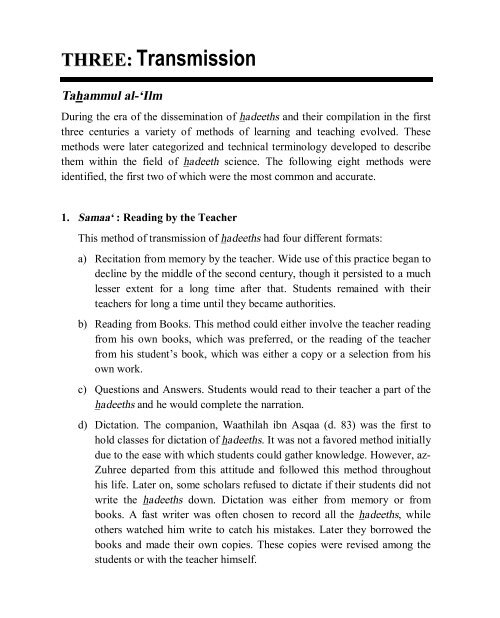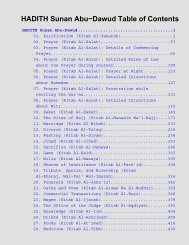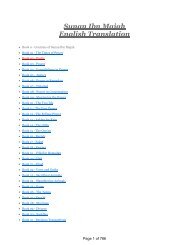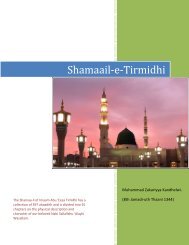- Page 2: [Usool Al Hadeeth]The Methodology o
- Page 6 and 7: from the Prophet of his actions, sa
- Page 8 and 9: 3. LawsOne of the primary duties of
- Page 10 and 11: authentically attributable to the P
- Page 12 and 13: was asked which city will be conque
- Page 14 and 15: Rahmaan, who was at that time the m
- Page 16 and 17: centuries. They also grouped the ha
- Page 18 and 19: Prophet's lifetime, and in the wars
- Page 22 and 23: 2. ‘Ard : Reading by the Students
- Page 24 and 25: Transmission TerminologyThe hadeeth
- Page 26 and 27: EVOLUTION OF THE SANADTeaching the
- Page 28 and 29: the Sahaabah had left off and began
- Page 30 and 31: In this case the Sanad is shorter b
- Page 32 and 33: The Pattern of IsnaadThe usual patt
- Page 35 and 36: Origins of the Isnaad SystemEvery t
- Page 37 and 38: FOUR: ClassificationDue to a variet
- Page 39 and 40: Hadeeth SaheehA hadeeth must meet t
- Page 41 and 42: Saheeh li GhayrihThe hadeeth saheeh
- Page 43 and 44: ecorded by others.5. Authentic hade
- Page 45 and 46: Abee Awfaa wrote to him saying that
- Page 47 and 48: Muhammad ibn Bashshaar informed us
- Page 49 and 50: Ruling on Da‘eef NarrationsSchola
- Page 51 and 52: In this narration, he deleted the c
- Page 53 and 54: called Taghleeq at-Ta‘leeq (Closi
- Page 55 and 56: The jurists (fuqahaa) generally def
- Page 57 and 58: Caesar’s emissary collected by Ah
- Page 59 and 60: Muwatta 42 with the following chain
- Page 61 and 62: Saqiyah called him Aboo Wahb al-Asa
- Page 63 and 64: Khateeb al-Baghdaadee’s book call
- Page 65 and 66: The Mu’annan is a hadeeth in whic
- Page 67 and 68: and the household of the Prophet (r
- Page 69 and 70: The supporters of each opinion fabr
- Page 71 and 72:
(Soorah al-Israa, 17: 79) he said t
- Page 73 and 74:
7. Inventions for Personal Motives:
- Page 75 and 76:
Zamakhasharee and ash-Shawkaanee.Li
- Page 77 and 78:
definitions by other scholars are:1
- Page 79 and 80:
FIVE: ConflictIn vast number of nar
- Page 81 and 82:
farewell Hajj as well as on other o
- Page 83 and 84:
caught) but on the fourth occasion
- Page 85 and 86:
hadeeth narrations. So much so that
- Page 87 and 88:
Mulaykah, 14 az-Zuhree 15 and Shu
- Page 89 and 90:
them in ash-Sha‘bee’s direction
- Page 91 and 92:
ased on the relative reliability of
- Page 93 and 94:
Step Four: The eras of the narrator
- Page 95 and 96:
) متواتِر بِال ْمعن
- Page 97 and 98:
have even claimed Ijmaa‘ (unanimi
- Page 99 and 100:
What further explains this Qur’aa
- Page 101 and 102:
Bukhaaree - the most correct book a
- Page 103 and 104:
3. ‘Abdullaah ibn ‘Umar said:
- Page 105 and 106:
of scholars. It is false because it
- Page 107 and 108:
This hadeeth was narrated from Anas
- Page 109 and 110:
the view that discrepancies between
- Page 111 and 112:
EIGHT: LiteratureThe origins of the
- Page 113 and 114:
collected hadeeths which were relat
- Page 115 and 116:
Ibn Hambal began lecturing on tradi
- Page 117 and 118:
students, and also to his sons and
- Page 119 and 120:
The final chapter is on Shamaa’il
- Page 121 and 122:
On many occasions al-Bukhaaree’s
- Page 123 and 124:
Saheeh of Muslim ibn al-Hajjaaj ibn
- Page 125 and 126:
have examined 500,000 hadeeths, and
- Page 127 and 128:
Islamic world. 43 Sunan Abee Daawoo
- Page 129 and 130:
them on account of its isnaad. I he
- Page 131 and 132:
Muslim. 56 The book does, however,
- Page 133 and 134:
Ad-Daaraqutnee rapidly acquired a s
- Page 135 and 136:
men had to be appointed to repeat h
- Page 137 and 138:
The Zawaa’id Work of al-Haythamee
- Page 139 and 140:
(iv) They had been used as a basis
- Page 141 and 142:
the well-known Kitaab al-Ansaab of
- Page 143 and 144:
notices of more than 40,000 narrato
- Page 145 and 146:
Zaynud-Deen al-‘Iraaqee (725-806/
- Page 147 and 148:
forced to leave the city and wander
- Page 149 and 150:
the author. But the work could not
- Page 151 and 152:
TEN: Women Scholars of HadeethHisto
- Page 153 and 154:
daughter of the distinguished juris
- Page 155 and 156:
turn lectured to many students, som
- Page 157 and 158:
excelled in the art of calligraphy
- Page 159 and 160:
occurs only in Mutayyin’s narrati
- Page 161 and 162:
Abu Bakr as-Siddeeq, then to Ali ib
- Page 163 and 164:
ف َأ َمسك َها ف َل
- Page 165 and 166:
Haakim, Muhammad ibn ‘Abdillaah a
- Page 167:
Thahabee, Muhammad ibn Ahmad ath-.





